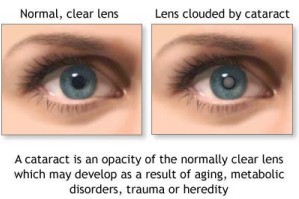A cataract is defined as the clouding of the
normally clear lens of the eye. This affects the vision by giving the sight a seemingly fogged-up or frosty vision. Cataracts progress gradually and do not usually disrupt eyesight at an early age. However, when it has developed, it will disturb vision significantly. This clouded vision can make an otherwise easy function, such as writing, reading and driving a car (particularly at night), a more difficult and consuming task. A cataract can occur in either eye or both eyes, however, it cannot spread from one eye to the second eye.
The lens in the eye is a clear part of the eye that helps focus an image or light on the retina, the photosensitive tissue at the back of the eye. The lens is necessary for the retina to receive a sharp image.
Types of Cataracts
Most cases of cataracts are involved with aging. The following types include:
- Traumatic cataract
- Develops after eye injury, not necessarily immediately (corneal abrasion, foreign body in the eye, etc.)
- Secondary cataract
- Occurs after surgery from other eye problems (glaucoma) or arises from other health problems (diabetes)
- Congenital cataract
- Inborn or developed in childhood
- May sometimes be due to inherited syndromes
- Radiation cataract
- Occurs after exposure to certain types of radiation (x-ray and cancer radiation therapy)
Risk Factors of Cataracts
Certain factors make the eyes more susceptible to cataracts. These include:
- Age
- Risk increases as one ages
- Certain diseases
- Diabetes
- High blood pressure
- Eye trauma
- Previous eye injury
- Previous eye trauma
- Personal behavior
- Nicotine use
- Alcohol abuse
- Obesity
- Environment
- Prolonged exposure to sunlight
- Exposure to ionizing radiation
- Genetics
- Family history of cataracts
- Use of corticosteroid medications for an extended period of time
Symptoms of Cataracts
When a cataract is small, it does not typically affect vision. Changes are only noticed once the cloudiness “grows,” which will then disrupt vision. Some symptoms of cataracts include:
- Blurred, clouded or dim vision
- Double vision in one eye
- Increasingly difficult with vision, especially at night
- Fading of colors, yellowing appearance
- Photosensitivity
- Seeing “halos” around lights
Treatment for Cataracts

- New glasses, magnification, increased lighting or other visual aids are usually advised for mild cases.
- In severe cases, cataract surgery is a very safe and successful in restoring clear vision.
It is essential to know of the dangers of eye injuries. To learn more about possible consequences from eye trauma, such as cataracts, enroll in workplace approved First Aid training.

